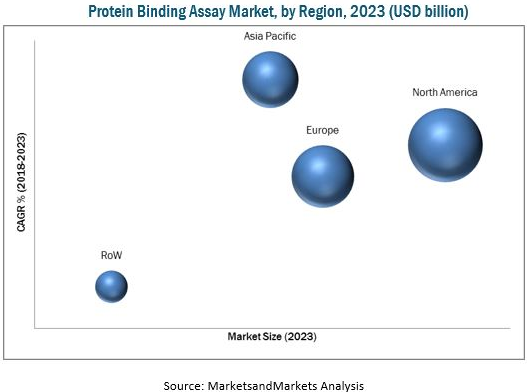The global Protein Binding Assays Market is projected to reach USD 425.7 million in 2023 from USD 256.1 million in 2018, at CAGR of 10.7%. The increasing use of protein binding assays in pre-clinical research for studying the distribution properties of the drug, and the growing number of drug discovery activities, the minimizing drug discovery and development costs, and the increase in pharmaceutical R&D expenditure is driving the growth of this market.
Objectives of the Study:
- To define, describe, and forecast the protein binding assay market on the basis of technology, end user, and regions
- To provide detailed information about factors influencing market growth (drivers, restraints, opportunities, and industry-specific challenges)
- To strategically analyze the micromarkets with respect to individual growth trends, prospects, and contributions to the overall market
- To analyze market opportunities for stakeholders and provide details of the competitive landscape for key players
- To forecast the size of the market segments with respect to four major regional segments, namely, North America, Europe, Asia Pacific, and the Rest of the World (RoW)
- To profile the key players in the market and comprehensively analyze their market positions and core competencies
- To track and analyze competitive developments such as partnerships, agreements, and joint ventures; mergers and acquisitions; product development; and research and development activities in the protein binding assay market
Based on technology, equilibrium dialysis segment is expected to grow at the highest CAGR in the market during the forecast period
On the basis of technology, the global protein binding assays market is divided into equilibrium dialysis, ultrafiltration, ultracentrifugation, and other technologies. In 2018, the equilibrium dialysis segment is expected to grow at the highest CAGR in the protein binding assays market. The growth can be attributed to the technique’s physical simplicity, low cost, and high accuracy. It is also considered as a gold standard technique for protein binding studies.
Download the PDF Brochure@
https://www.marketsandmarkets.com/pdfdownloadNew.asp?id=44025612
Based on end user, Contract Research Organizations (CROs) segment is expected to grow at the highest CAGR in the market during the forecast period
On the basis of end user, the global protein binding assays market is divided into pharmaceutical and biotechnology companies, CROs, and other end users. In 2018, the CROs segment is expected to grow at the highest CAGR in the global protein binding assays market. This high growth can be attributed to the increase increased protein binding studies for drug discovery & development by pharmaceuticals and the growing focus of biotechnology companies on developing biologics.
Asia Pacific is expected to grow at the highest CAGR during the forecast period
The APAC market is projected to register the highest growth rate during the forecast period primarily due to factors such as, growth of clinical trial activities in several APAC countries. As a result of this, the pharmaceutical and biopharmaceutical companies are outsourcing their drug discovery and development activities to APAC-based CROs. This is one of the major factors driving the growth of the protein binding assay market in the Asia Pacific.
The key players operating in the protein binding assay market are Thermo Fisher Scientific (US), GE Healthcare (US), Danaher (US), and Merck (Germany).
Target Audience:
- Government and academic institutes
- Protein binding assay providers
- R&D departments
- Contract research organizations
- Pharmaceutical & biotechnology companies
- Consulting firms
- Government associations
You Can Also Talk to Our Research Experts for More Detailed Information@ http://bit.ly/2CbBPYn
